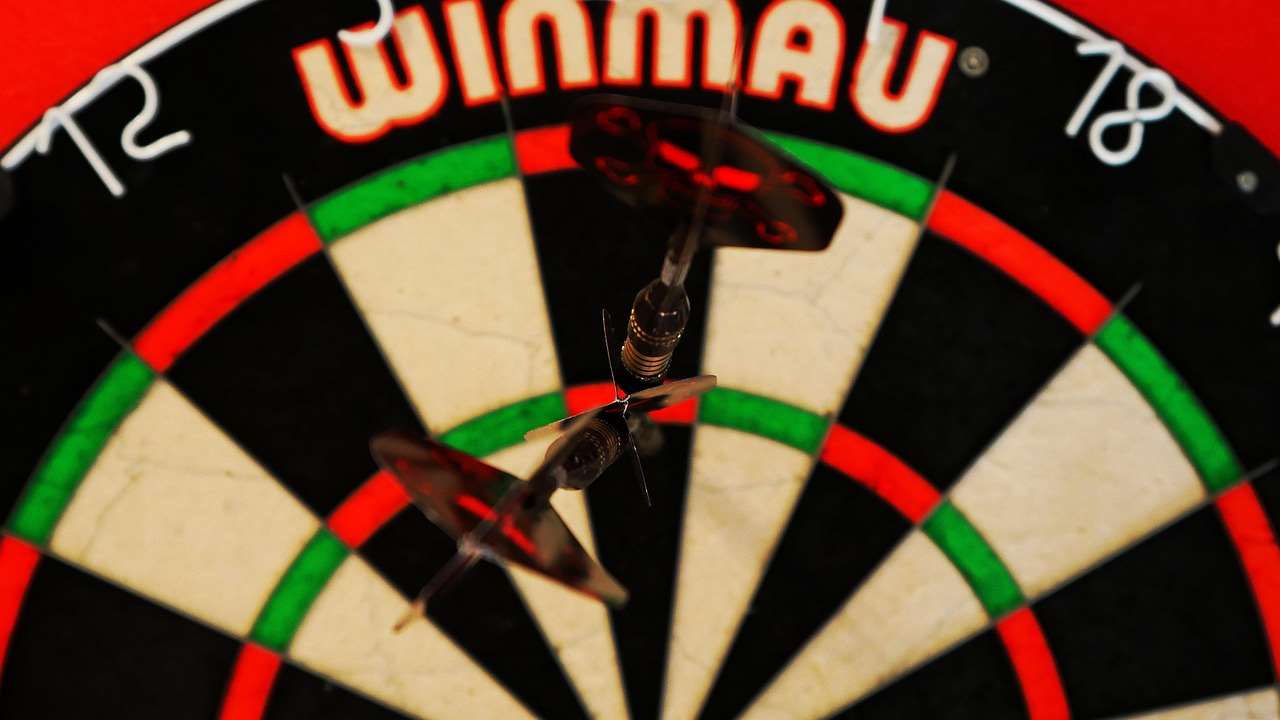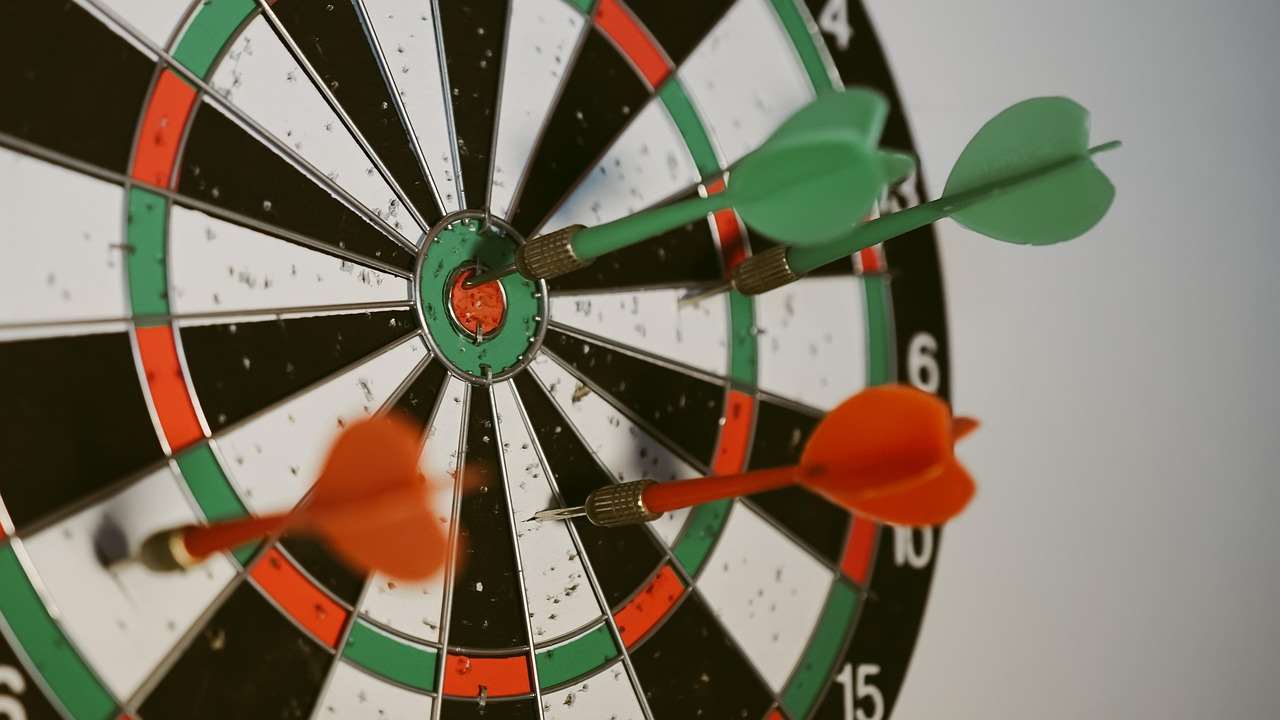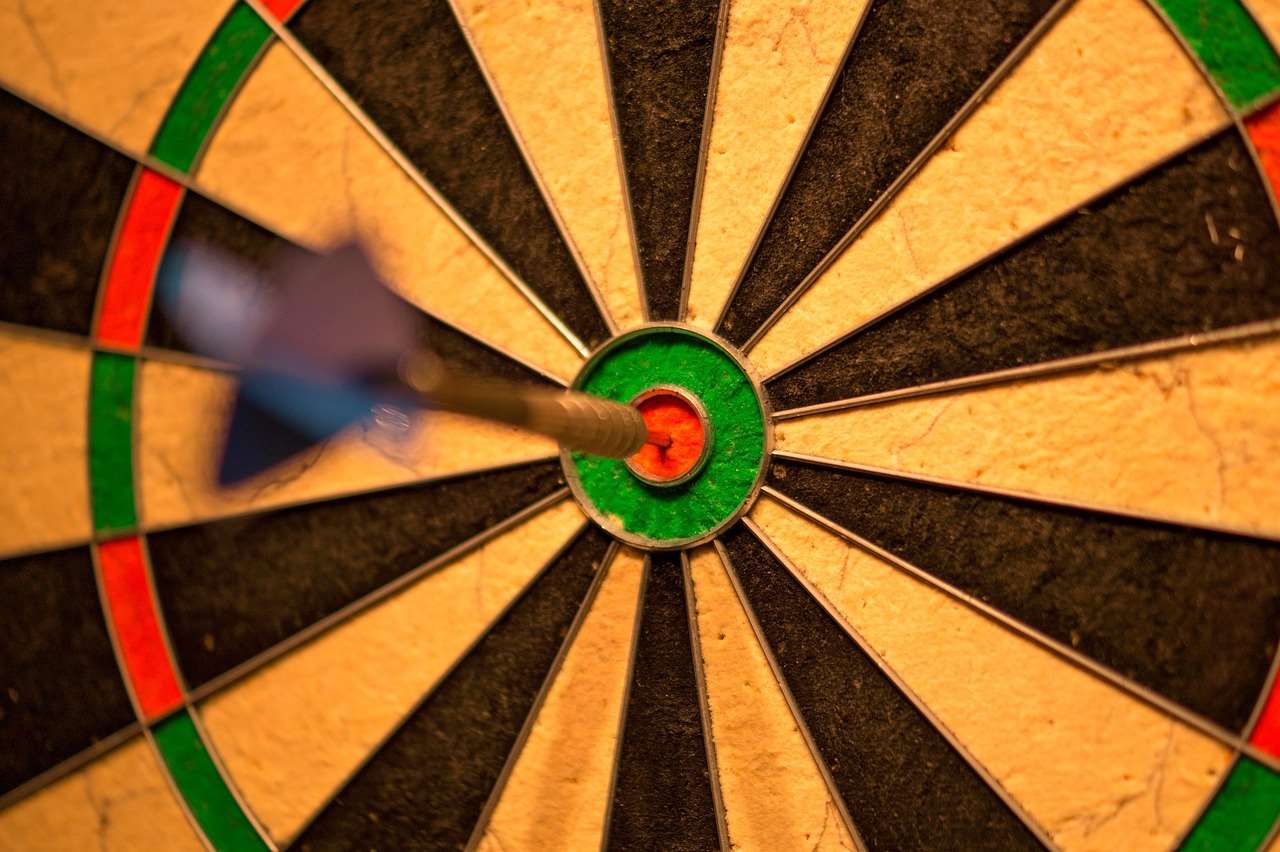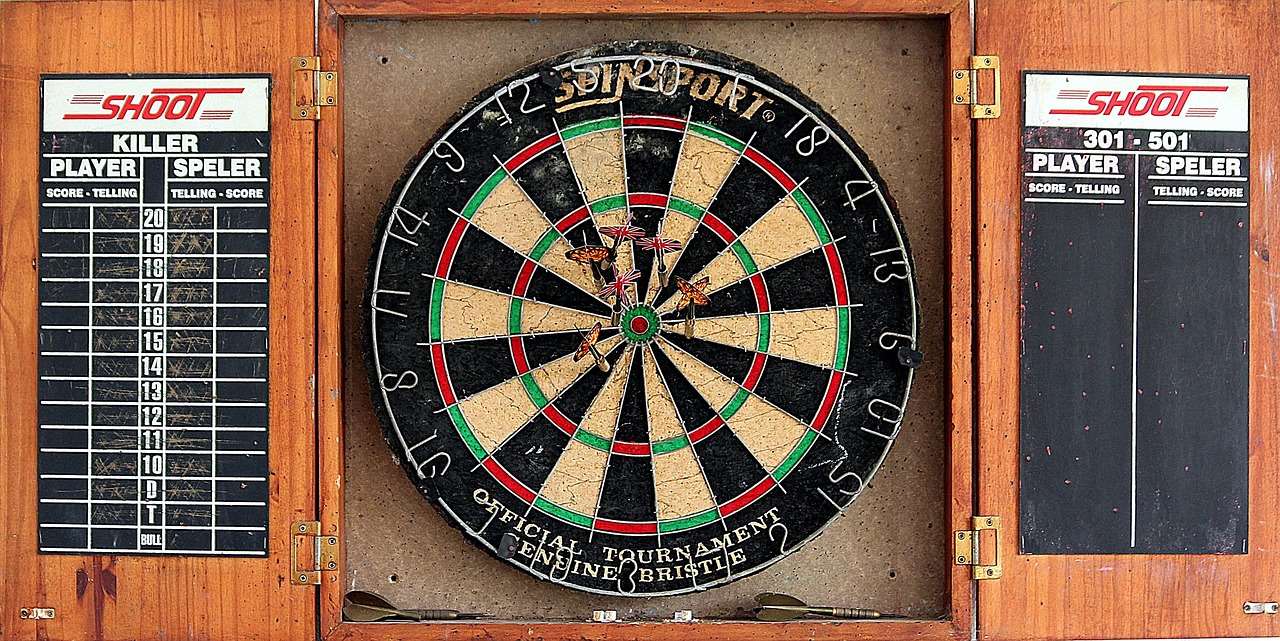Understanding **darts score** is fundamental to enjoying and mastering the game. Each section on a dartboard has a specific point value, with the ultimate goal being to reduce your starting score (usually 501 or 301) to zero. This article will guide you through the scoring system, common game variations, strategies for maximizing your score, and helpful tips to improve your **darts score**.
⚠️ Still Using Pen & Paper (or a Chalkboard)?! ⚠️
Step into the future! The Dart Counter App handles all the scoring, suggests checkouts, and tracks your stats automatically. It's easier than you think!
Try the Smart Dart Counter App FREE!Ready for an upgrade? Click above!
Decoding the Darts Score System
The standard dartboard is divided into 20 numbered sections, each worth a value from 1 to 20. Within these sections are several key areas that drastically affect the darts score:
- Single Segments: The largest areas within each numbered section, simply worth the number indicated.
- Double Ring: The outer ring of the dartboard. A dart landing in this ring scores double the value of the corresponding numbered section. This is crucial for finishing games.
- Treble Ring: The inner ring of the dartboard. A dart landing in this ring scores triple the value of the corresponding numbered section. This is a high-scoring target for experienced players.
- Bullseye: The center of the dartboard. The outer green ring is worth 25 points (single bull), and the inner red circle is worth 50 points (double bull).
Misunderstanding these segments can significantly impact your darts score. A common mistake is aiming for the treble 20 but accidentally hitting the single 1 or 5, resulting in a much lower score than intended.

Common Scoring Errors and How to Avoid Them
Even experienced players occasionally make scoring errors. Here are some common mistakes and tips on how to avoid them:
- Misreading the Dartboard: Ensure you are familiar with the layout of the dartboard, especially the placement of low-value numbers next to high-value ones.
- Incorrectly Adding Scores: Double-check your calculations after each throw, particularly when playing quickly or under pressure.
- Forgetting to Declare Your Score: In some games, it is required to announce your remaining score before throwing. Forgetting to do so can result in penalties.
- Busting: Going below zero or finishing on a double or bullseye when the rules require a specific finish.
Using a darts scorer with voice can help prevent calculation errors, especially during intense matches. Knowing how to properly score is vital; you don’t want to celebrate prematurely and accidentally miss the victory.
Popular Darts Games and Scoring Variations
While the basic scoring system remains consistent, different dart games introduce unique rules and objectives, impacting the overall strategy and how the darts score is managed.
501 and 301: The Classic Choice
501 and 301 are the most popular darts games. Each player starts with either 501 or 301 points and must reduce their score to exactly zero. The final dart must land on a double or the bullseye (which counts as a double 25). “Busting” occurs when a player’s score goes below zero or reaches zero without hitting a double or bullseye on the final dart. If a player busts, the score reverts to what it was at the start of that turn. A good strategy involves setting yourself up for easy doubles like double 20 or double 16.
Around the Clock
In “Around the Clock” (also known as “Around the World”), the goal is to hit each number on the dartboard in sequence, starting with 1 and ending with 20. Some variations require hitting each number three times, while others require hitting only one. The winner is the first player to successfully hit all the numbers in order. This game is excellent for practicing accuracy and consistency.
Cricket
Cricket involves “closing” numbers by hitting them three times each. The numbers used are typically 20, 19, 18, 17, 16, 15, and the bullseye. Once a player has closed a number, they score points on that number each time they hit it, as long as their opponent hasn’t closed it yet. The winner is the first player to close all the required numbers and have a higher or equal **darts score** than their opponent. Cricket requires strategic thinking and defensive play.

Strategies to Maximize Your Darts Score
Improving your darts score involves more than just understanding the rules. Implementing effective strategies and practicing consistently can significantly enhance your performance.
Aiming for the Treble 20
The treble 20 is the highest-scoring single target on the dartboard, yielding 60 points. Consistently hitting the treble 20 can dramatically increase your average **darts score**. Focus on developing a smooth and repeatable throwing motion to improve your accuracy when targeting this crucial segment.
Setting Up Your Finishes
Effective finish planning is crucial in 501 and 301. As you approach the end of a game, aim to leave yourself with a score that can be easily finished with a double. Common finish combinations include double 20 (40), double 16 (32), and double 12 (24). Practice these finishes to increase your confidence under pressure. Understanding the mathematics behind common finishes can give you a strategic advantage.
Consistent Practice and Routine
Regular practice is essential for improving your darts score. Establish a consistent practice routine that focuses on both accuracy and scoring. Experiment with different throwing techniques to find what works best for you. Furthermore, you might consider utilizing a Digital dart score app to keep track of your practice session.
Advanced Techniques for Darts Scoring
Once you’ve mastered the basics, you can explore more advanced techniques to further enhance your **darts score** and overall game.
Using the Oche Effectively
The oche (throwing line) is your starting point for every throw. Finding a comfortable and consistent stance at the oche is crucial for accuracy. Experiment with different foot positions and body alignments to find what works best for you. Make sure you know the correct distance from the raised darts oche argos to the dartboard.
Mental Toughness and Focus
Darts is as much a mental game as it is a physical one. Developing mental toughness and the ability to focus under pressure can significantly improve your **darts score**. Practice visualizing successful throws and maintaining a positive attitude, even after setbacks. Learning to control your emotions and stay calm in critical moments can be a game-changer.

Understanding Dart Trajectory and Physics
A deeper understanding of dart trajectory and the physics behind the throw can provide valuable insights. Consider factors such as dart weight, flight shape, and throwing speed. Experiment with different dart setups to find the combination that best suits your throwing style. Analyzing your throws and making small adjustments based on the results can lead to significant improvements in accuracy and consistency. It’s similar to understanding ballistics in other sports; the more you understand the physics, the better you can control your shot. Remember the importance of knowing how to dart board install correctly for optimal play.
Choosing the Right Darts Equipment for Better Scores
Your equipment can influence your **darts score** and overall performance. Selecting the right darts, flights, and shafts can make a noticeable difference.
Dart Weight and Material
Darts are available in various weights, typically ranging from 18 to 30 grams. The ideal weight depends on your personal preference and throwing style. Heavier darts tend to be more stable in the air, while lighter darts may offer greater control. The material of the dart, such as tungsten or brass, can also affect its balance and grip. Tungsten darts are denser and allow for a slimmer barrel, which can improve grouping.
Flights and Shafts
Flights and shafts play a crucial role in dart stability and trajectory. Flights come in various shapes and sizes, each affecting the dart’s aerodynamics differently. Larger flights provide more stability, while smaller flights offer less drag and faster speed. Shafts connect the flight to the barrel and come in different lengths and materials. Experiment with different combinations to find the setup that produces the most consistent and accurate throws. Don’t forget to consider the latest target darts new product launch for innovative options.
Dartboard Quality and Maintenance
The quality of your dartboard also affects your **darts score**. A high-quality dartboard will have consistent sisal fibers, which allow darts to stick easily and reduce bounce-outs. Rotate your dartboard regularly to distribute wear evenly and prolong its lifespan. Proper maintenance, such as removing loose fibers and keeping the board clean, will ensure optimal performance. Understanding how to mount a dartboard on drywall correctly is also crucial for stability and preventing damage.

Analyzing Your Performance to Improve Your Darts Score
Tracking and analyzing your performance is essential for identifying areas for improvement and maximizing your darts score. Keeping a record of your throws, scores, and finishing percentages can provide valuable insights into your strengths and weaknesses.
Tracking Your Progress
Use a notebook or a digital app to record your scores, averages, and other relevant statistics. Track your performance over time to monitor your progress and identify trends. Pay attention to your finishing percentages and areas where you consistently struggle. This data will help you focus your practice efforts on the areas that need the most improvement. Consider using a darts score 180 tracker to monitor high scores.
Identifying Weaknesses
Analyze your data to identify specific weaknesses in your game. Are you struggling with certain numbers or finishes? Are you consistently missing the treble 20? Once you’ve identified your weaknesses, develop a practice plan to address them. Focus on the specific areas where you need the most improvement, and track your progress as you work to overcome these challenges. Remember, acknowledging weaknesses is the first step toward improvement.
Adjusting Your Strategy
Based on your performance analysis, adjust your strategy as needed. If you’re consistently missing certain targets, consider changing your aiming point or throwing technique. If you’re struggling with certain finishes, practice those combinations until you become more comfortable. Be willing to adapt your strategy based on your performance and feedback from others. Flexibility and adaptability are key to continuous improvement in darts.
Tips for Consistent Darts Scoring
Consistency is key to achieving a high **darts score** and consistently winning matches. Implement these tips to improve your consistency and accuracy on the dartboard.
Develop a Pre-Throw Routine
Establish a consistent pre-throw routine to help you focus and maintain a consistent throwing motion. This routine may include taking a specific stance, gripping the dart in a certain way, and taking a few deep breaths. By repeating the same routine before each throw, you can create a sense of rhythm and predictability that promotes consistency. Like free throw routines in basketball, it’s crucial for success.
Practice Proper Grip and Stance
Your grip and stance are fundamental to your throwing motion. Experiment with different grips to find the one that feels most comfortable and provides the best control. Ensure that your stance is stable and balanced, with your weight evenly distributed. Practice maintaining a consistent grip and stance throughout your practice sessions to develop muscle memory and improve your consistency. Even small adjustments can have a significant impact on your accuracy and **darts score**.

Stay Relaxed and Focused
Tension and anxiety can negatively impact your throwing motion and accuracy. Stay relaxed and focused by taking deep breaths and visualizing successful throws. Avoid overthinking your throws and trust your muscle memory. Focus on your target and maintain a positive attitude, even after setbacks. A calm and focused mindset will help you maintain consistency and improve your **darts score**.
Conclusion
Mastering **darts score** involves understanding the scoring system, employing effective strategies, and practicing consistently. From understanding the value of each segment to planning your finishes and choosing the right equipment, every aspect contributes to your overall performance. By analyzing your progress, identifying weaknesses, and implementing consistent practice routines, you can significantly improve your accuracy and increase your **darts score**. So, grab your darts, practice these techniques, and aim for that perfect score! Don’t forget to track your progress and share your achievements with fellow dart enthusiasts.
Hi, I’m Dieter, and I created Dartcounter (Dartcounterapp.com). My motivation wasn’t being a darts expert – quite the opposite! When I first started playing, I loved the game but found keeping accurate scores and tracking stats difficult and distracting.
I figured I couldn’t be the only one struggling with this. So, I decided to build a solution: an easy-to-use application that everyone, no matter their experience level, could use to manage scoring effortlessly.
My goal for Dartcounter was simple: let the app handle the numbers – the scoring, the averages, the stats, even checkout suggestions – so players could focus purely on their throw and enjoying the game. It began as a way to solve my own beginner’s problem, and I’m thrilled it has grown into a helpful tool for the wider darts community.